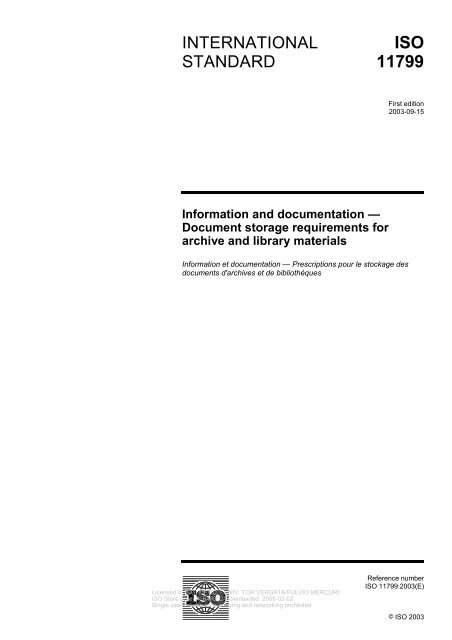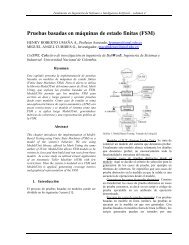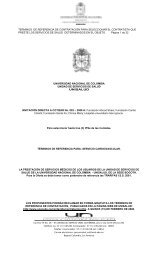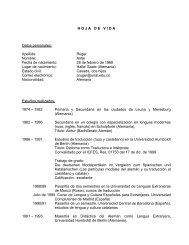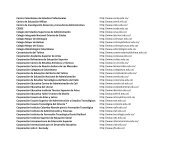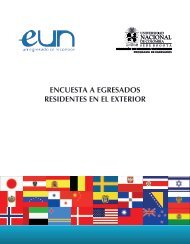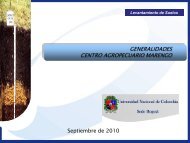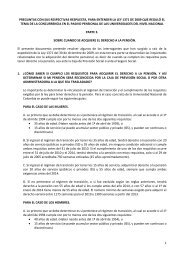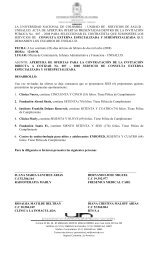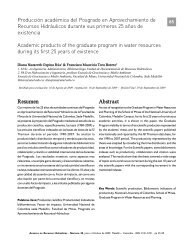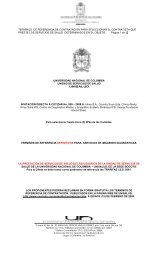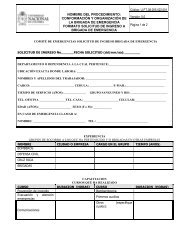ISO 11799
ISO 11799
ISO 11799
You also want an ePaper? Increase the reach of your titles
YUMPU automatically turns print PDFs into web optimized ePapers that Google loves.
INTERNATIONAL<br />
STANDARD<br />
<strong>ISO</strong><br />
<strong>11799</strong><br />
First edition<br />
2003-09-15<br />
Information and documentation —<br />
Document storage requirements for<br />
archive and library materials<br />
Information et documentation — Prescriptions pour le stockage des<br />
documents d'archives et de bibliothèques<br />
Licensed to ING. MECC. - UNIV. TOR VERGATA/FULVIO MERCURI<br />
<strong>ISO</strong> Store order #: 648902/Downloaded: 2005-02-02<br />
Single user licence only, copying and networking prohibited<br />
Reference number<br />
<strong>ISO</strong> <strong>11799</strong>:2003(E)<br />
© <strong>ISO</strong> 2003
<strong>ISO</strong> <strong>11799</strong>:2003(E)<br />
PDF disclaimer<br />
This PDF file may contain embedded typefaces. In accordance with Adobe's licensing policy, this file may be printed or viewed but<br />
shall not be edited unless the typefaces which are embedded are licensed to and installed on the computer performing the editing. In<br />
downloading this file, parties accept therein the responsibility of not infringing Adobe's licensing policy. The <strong>ISO</strong> Central Secretariat<br />
accepts no liability in this area.<br />
Adobe is a trademark of Adobe Systems Incorporated.<br />
Details of the software products used to create this PDF file can be found in the General Info relative to the file; the PDF-creation<br />
parameters were optimized for printing. Every care has been taken to ensure that the file is suitable for use by <strong>ISO</strong> member bodies. In<br />
the unlikely event that a problem relating to it is found, please inform the Central Secretariat at the address given below.<br />
© <strong>ISO</strong> 2003<br />
All rights reserved. Unless otherwise specified, no part of this publication may be reproduced or utilized in any form or by any means,<br />
electronic or mechanical, including photocopying and microfilm, without permission in writing from either <strong>ISO</strong> at the address below or<br />
<strong>ISO</strong>'s member body in the country of the requester.<br />
<strong>ISO</strong> copyright office<br />
Case postale 56 • CH-1211 Geneva 20<br />
Tel. + 41 22 749 01 11<br />
Fax + 41 22 749 09 47<br />
E-mail copyright@iso.org<br />
Web www.iso.org<br />
Published in Switzerland<br />
ii<br />
Licensed to ING. MECC. - UNIV. TOR VERGATA/FULVIO MERCURI<br />
<strong>ISO</strong> Store order #: 648902/Downloaded: 2005-02-02<br />
Single user licence only, copying and networking prohibited<br />
© <strong>ISO</strong> 2003 — All rights reserved
<strong>ISO</strong> <strong>11799</strong>:2003(E)<br />
Contents<br />
Page<br />
Foreword............................................................................................................................................................ iv<br />
Introduction ........................................................................................................................................................ v<br />
1 Scope...................................................................................................................................................... 1<br />
2 Normative references ........................................................................................................................... 1<br />
3 Terms and definitions........................................................................................................................... 2<br />
4 Site of the building................................................................................................................................ 2<br />
5 Construction of the building................................................................................................................ 2<br />
6 Installation and equipment................................................................................................................... 3<br />
7 Use.......................................................................................................................................................... 8<br />
8 Disaster-control plan ............................................................................................................................ 9<br />
9 Exhibitions............................................................................................................................................. 9<br />
Annex A (informative) Maximum limits tolerance for air pollutants............................................................ 10<br />
Annex B (informative) Recommended climatic conditions for the long-term storage of archive<br />
and library materials ........................................................................................................................... 11<br />
Annex C (informative) Disaster preparedness............................................................................................... 13<br />
Bibliography ..................................................................................................................................................... 14<br />
Licensed to ING. MECC. - UNIV. TOR VERGATA/FULVIO MERCURI<br />
<strong>ISO</strong> Store order #: 648902/Downloaded: 2005-02-02<br />
Single user licence only, copying and networking prohibited<br />
© <strong>ISO</strong> 2003 — All rights reserved iii
<strong>ISO</strong> <strong>11799</strong>:2003(E)<br />
Foreword<br />
<strong>ISO</strong> (the International Organization for Standardization) is a worldwide federation of national standards bodies<br />
(<strong>ISO</strong> member bodies). The work of preparing International Standards is normally carried out through <strong>ISO</strong><br />
technical committees. Each member body interested in a subject for which a technical committee has been<br />
established has the right to be represented on that committee. International organizations, governmental and<br />
non-governmental, in liaison with <strong>ISO</strong>, also take part in the work. <strong>ISO</strong> collaborates closely with the<br />
International Electrotechnical Commission (IEC) on all matters of electrotechnical standardization.<br />
International Standards are drafted in accordance with the rules given in the <strong>ISO</strong>/IEC Directives, Part 2.<br />
The main task of technical committees is to prepare International Standards. Draft International Standards<br />
adopted by the technical committees are circulated to the member bodies for voting. Publication as an<br />
International Standard requires approval by at least 75 % of the member bodies casting a vote.<br />
Attention is drawn to the possibility that some of the elements of this document may be the subject of patent<br />
rights. <strong>ISO</strong> shall not be held responsible for identifying any or all such patent rights.<br />
<strong>ISO</strong> <strong>11799</strong> was prepared by Technical Committee <strong>ISO</strong>/TC 46, Information and documentation.<br />
iv<br />
Licensed to ING. MECC. - UNIV. TOR VERGATA/FULVIO MERCURI<br />
<strong>ISO</strong> Store order #: 648902/Downloaded: 2005-02-02<br />
Single user licence only, copying and networking prohibited<br />
© <strong>ISO</strong> 2003 — All rights reserved
<strong>ISO</strong> <strong>11799</strong>:2003(E)<br />
Introduction<br />
Archives and libraries are institutions established by society in order to collect, preserve and make available<br />
documents intended for consultation, by viewing directly or via a screen, or, in the case of sound recordings,<br />
by ear.<br />
Archive and library collections normally contain material in a wide variety of formats. These are mainly paperbased<br />
books, manuscripts, files, records, maps and graphic collections, but may also include vellum,<br />
parchment, papyrus, film, photographic materials, audiovisual material, magnetic and optical media, and<br />
machine-readable formats. All these materials ideally require specific storage conditions.<br />
Documents for current use may require different storage conditions from those requiring long-term or indefinite<br />
preservation.<br />
This International Standard applies to the long-term storage of archive and library materials, but takes into<br />
account that, as the materials are stored to allow current use as well, some compromise with the ideal<br />
conditions for long-term storage may be unavoidable.<br />
Depending on the climate and economic situation of a country, it may be difficult to create and maintain ideal<br />
conditions for the long-term storage of archive and library materials.<br />
Figures and quantities given in this International Standard are intended for general international guidance.<br />
This International Standard presents some facts and general rules which should be considered when a<br />
building for the purpose of archival storage is newly constructed, when an old building originally designed for<br />
another use is converted, or when a building already in use for this purpose is renovated.<br />
Licensed to ING. MECC. - UNIV. TOR VERGATA/FULVIO MERCURI<br />
<strong>ISO</strong> Store order #: 648902/Downloaded: 2005-02-02<br />
Single user licence only, copying and networking prohibited<br />
© <strong>ISO</strong> 2003 — All rights reserved v
Licensed to ING. MECC. - UNIV. TOR VERGATA/FULVIO MERCURI<br />
<strong>ISO</strong> Store order #: 648902/Downloaded: 2005-02-02<br />
Single user licence only, copying and networking prohibited
INTERNATIONAL STANDARD<br />
<strong>ISO</strong> <strong>11799</strong>:2003(E)<br />
Information and documentation — Document storage<br />
requirements for archive and library materials<br />
1 Scope<br />
This International Standard specifies the characteristics of general-purpose repositories used for the long-term<br />
storage of archive and library materials. It covers the sitting and construction of the building and the<br />
installation and equipment to be used.<br />
It applies to all archive and library materials held in general-purpose repositories, where mixed media may be<br />
stored together. It does not preclude the establishment of separate areas or compartments within individual<br />
repositories, where the environment can be controlled to create conditions suiting the needs of specific<br />
archive materials.<br />
It does not cover special requirements for the long-term storage of not or not fully paper-based documents<br />
such as parchment or vellum, photographic documents or machine-readable documents.<br />
It also does not cover repository management procedures.<br />
In a number of fields, national or local building regulations may cover in detail such matters as construction,<br />
safety and security for public buildings and buildings in which valuable objects are stored (fire precautions,<br />
emergency exits, security against earthquakes, theft, burglary, terrorist acts, etc.), as well as services and<br />
equipment in professional use. This International Standard therefore avoids detailed rules and regulations in<br />
these fields, except when recommending what may be additions to these requirements.<br />
2 Normative references<br />
The following referenced documents are indispensable for the application of this document. For dated<br />
references, only the edition cited applies. For undated references, the latest edition of the referenced<br />
document (including any amendments) applies.<br />
<strong>ISO</strong> 9706:1994, Information and documentation — Paper for documents — Requirements for permanence<br />
<strong>ISO</strong> 12606:1997, Cinematography — Care and preservation of magnetic audio recordings for motion pictures<br />
and television<br />
<strong>ISO</strong> 18902, Imaging materials — Processed photographic films, plates and papers — Filing enclosures and<br />
storage containers<br />
<strong>ISO</strong> 18911, Imaging materials — Processed safety photographic films — Storage practices<br />
<strong>ISO</strong> 18918:2000, Imaging materials — Processed photographic plates — Storage practices<br />
<strong>ISO</strong> 18920:2000, Imaging materials — Processed photographic reflection prints — Storage practices<br />
<strong>ISO</strong> 18923:2000, Imaging materials — Polyester base magnetic tape — Storage practices<br />
<strong>ISO</strong> 18925, Imaging materials — Optical disc media — Storage practices<br />
Licensed to ING. MECC. - UNIV. TOR VERGATA/FULVIO MERCURI<br />
<strong>ISO</strong> Store order #: 648902/Downloaded: 2005-02-02<br />
Single user licence only, copying and networking prohibited<br />
© <strong>ISO</strong> 2003 — All rights reserved 1
<strong>ISO</strong> <strong>11799</strong>:2003(E)<br />
3 Terms and definitions<br />
For the purposes of this document, the following terms and definitions apply.<br />
3.1<br />
archive and library materials<br />
all types of documents kept in archives and libraries, mainly books, manuscripts, files, records, maps, graphic<br />
collections and other documents consisting of paper, but also parchment, papyrus, films, photographic<br />
materials, audiovisual recordings, magnetic and optical media, as well as bindings and protective material<br />
3.2<br />
document<br />
recorded information or material object which can be treated as a unit in a documentation process<br />
3.3<br />
long-term storage<br />
storage, for a period of undefined length, of material kept for permanent retention<br />
3.4<br />
repository<br />
building or room designed or arranged and used specifically and exclusively for long-term storage of archive<br />
and library materials<br />
4 Site of the building<br />
The site for an archive and/or library repository building should not be<br />
⎯<br />
⎯<br />
⎯<br />
⎯<br />
⎯<br />
⎯<br />
⎯<br />
liable to subsidence or flooding,<br />
especially at risk from earthquakes, tidal waves or landslides,<br />
at risk from fire or explosions in adjacent sites,<br />
near a place or a building which attracts rodents, insects and other pests,<br />
near a plant or installation emitting harmful gases, smoke, dust, etc.,<br />
in an especially polluted area, nor<br />
near a strategic installation which could be a target in an armed conflict.<br />
If these requirements cannot be met, special provision shall be made in the construction of the building to<br />
defend against these threats.<br />
In order to minimize the harmful effects of exposure to sunlight, careful attention should be paid to orientation,<br />
landscaping and the site’s microclimate.<br />
5 Construction of the building<br />
5.1 Self-containment and security<br />
The repository shall be secured against theft, burglary, vandalism and terrorism. Precautions should be taken<br />
against arson. The repository shall be either a purpose-built detached building or a self-contained unit within a<br />
building. There shall be only one entrance for visitors. Precautions shall be taken against any other entrances<br />
being used by unauthorized people.<br />
Licensed to ING. MECC. - UNIV. TOR VERGATA/FULVIO MERCURI<br />
<strong>ISO</strong> Store order #: 648902/Downloaded: 2005-02-02<br />
Single user licence only, copying and networking prohibited<br />
2 © <strong>ISO</strong> 2003 — All rights reserved
<strong>ISO</strong> <strong>11799</strong>:2003(E)<br />
NOTE 1<br />
For more information on precautions against arson, see reference [1] in the Bibliography.<br />
Emergency exits shall be constructed in such a way that they can easily be opened from the inside and that<br />
they cannot be opened from the outside.<br />
NOTE 2<br />
National regulations regarding exits may apply.<br />
In the interests of security and climatic inertia, and also in order to protect archive and library materials from<br />
exposure to harmful light, the storage areas should have no windows. If there are windows, they shall be fitted<br />
in such a way as to exclude direct daylight (see also 6.5).<br />
5.2 Climatic inertia<br />
The repository should be designed to provide an accurate and stable internal environment, with minimum<br />
dependence on mechanical systems. This can be partially achieved by constructing the external walls, roof<br />
and floor of the building from materials that, as far as possible, insulate the interior from external climatic<br />
changes.<br />
Walls, floors and ceilings inside the repository should be made of materials that have a high thermal capacity.<br />
In areas of the world where the relative humidity does not exceed the recommended values for prolonged<br />
periods of time, building materials with a high hygroscopic capacity are also recommended (see 6.7).<br />
NOTE 1<br />
NOTE 2<br />
For example, brick is a material with both high thermal and high hygroscopic capacity.<br />
For more information on climatic inertia, see reference [2] in the Bibliography.<br />
5.3 Inner structure and load<br />
For reasons of fire safety and efficient climate control, the area used as a repository should be divided into<br />
compartments.<br />
NOTE 1<br />
The maximum size of a fire compartment is normally given in national regulations.<br />
The walls (including doors), floors and ceilings between single rooms and compartments, and between<br />
storage and other areas of the building shall be constructed so as to prevent fire (and water) from spreading<br />
into a neighbouring unit. A minimum of 2 h of fire resistance is recommended. Doors should be self-closing<br />
and should normally be kept in a closed position. Where it becomes necessary to keep doors open under<br />
normal use, they should be fitted with magnetic hold-open devices which release to permit automatic door<br />
closing upon activation of the building fire alarm/detection system. Door sills should be avoided unless<br />
absolutely essential (for example for flood prevention), in which case ramps should be provided.<br />
The materials used for all inside surfaces shall not be combustible nor emit, attract or retain dust. Nor shall<br />
they be liable, through decomposition in the event of fire or for other reasons, to emit substances harmful to<br />
the materials stored, e.g. acidic gases. The choice of material shall minimize, in the case of fire, the emission<br />
of harmful substances, smoke and soot.<br />
NOTE 2 Methods to test the surface-burning characteristics of building materials (flame spread and smoke generation)<br />
are given in references [3] and [4] in the Bibliography.<br />
When constructing the floors, it shall be taken into account that densely stored archive and library materials<br />
can have a considerable weight. A structural engineer should calculate and recommend floor-loading<br />
requirements based on the density and quantity of the materials stored.<br />
6 Installation and equipment<br />
Use the following International Standards whenever possible: <strong>ISO</strong> 12606, <strong>ISO</strong> 18911, <strong>ISO</strong> 18918, <strong>ISO</strong> 18920,<br />
<strong>ISO</strong> 18923, <strong>ISO</strong> 18925.<br />
Licensed to ING. MECC. - UNIV. TOR VERGATA/FULVIO MERCURI<br />
<strong>ISO</strong> Store order #: 648902/Downloaded: 2005-02-02<br />
Single user licence only, copying and networking prohibited<br />
© <strong>ISO</strong> 2003 — All rights reserved 3
<strong>ISO</strong> <strong>11799</strong>:2003(E)<br />
6.1 Services<br />
Supply systems for electricity, gas, and especially for water, shall not be located in or near a room in the<br />
repository, unless needed in that room for a specific function directly connected with the collections.<br />
Installations providing temperature/humidity control, air filtration and ventilation systems shall be connected to<br />
a central plant room. This room shall not be in the same fire compartment as the storage area, and should<br />
preferably be in a separate building.<br />
6.2 Fire detection system<br />
All parts of the building shall be provided with a fire detection system connected to a central monitoring panel.<br />
Such a system shall respond automatically to the presence of fire by detecting smoke or other products of<br />
combustion. Heat detection devices shall only be installed as the sole method of detection in areas such as<br />
plant rooms where other types of detectors may be inappropriate or unsuitable. All parts of the building shall,<br />
in addition, be provided with manually operated fire-alarm call points which can be used by occupants to<br />
indicate the presence of a fire.<br />
The operation of the detection system shall result in the following actions:<br />
⎯<br />
⎯<br />
⎯<br />
⎯<br />
a local warning at the control panel and/or repeater panels, indicating where a fire has been detected;<br />
operation of plant shut-down, such as air conditioning or heating systems;<br />
automatic transmission of a warning to the local fire brigade or central alarm station;<br />
general fire-alarm warning throughout the repository building.<br />
The central fire-alarm control panel should provide a facility to monitor all components of the system and<br />
should visually display the status of the system. Panels should be located in a convenient, central location<br />
which is continuously manned or is manned while the repository is occupied or open. Where the panel is not<br />
located at or near the probable fire-brigade entry point, a supplementary or repeater panel should be provided<br />
for the use of the fire brigade.<br />
NOTE<br />
National or local fire-alarm codes may apply.<br />
6.3 Fire extinguishing system<br />
Consideration should be given to the benefits offered by an automatic fire fighting system. Gas- or waterbased<br />
fire fighting systems are accepted in repositories.<br />
Where automatic fire extinguishing systems are used, they shall be regularly inspected and maintained. They<br />
shall be designed to minimize damage to archive and library materials from fire and fire-suppression action.<br />
NOTE 1 Properly designed, installed and maintained sprinkler systems do far less damage than manually fighting a fire<br />
that has not been contained by a sprinkler system. Possible malfunction of a sprinkler system, however, may cause<br />
severe damage to documents.<br />
NOTE 2 Water-mist systems currently being researched for library and archive use apply small amounts of water at<br />
very high pressure and may offer a substantial advantage over conventional sprinkler systems. A principal advantage of<br />
water mist is that, when correctly designed and installed, all the water discharged should turn to vapour and leave virtually<br />
no residual water. Research is still in progress to determine whether water-mist systems are effective in high-density<br />
storage systems utilizing compact shelving or in repositories employing very high shelving.<br />
Where water-based fire protection systems are to be installed, provision shall be made for rapid drainage from<br />
all protected spaces. Shafts, staircases and drains should be so configured that water leaving one space does<br />
not enter another. Intermediate floors in multi-storey repositories should be waterproofed.<br />
Licensed to ING. MECC. - UNIV. TOR VERGATA/FULVIO MERCURI<br />
<strong>ISO</strong> Store order #: 648902/Downloaded: 2005-02-02<br />
Single user licence only, copying and networking prohibited<br />
4 © <strong>ISO</strong> 2003 — All rights reserved
<strong>ISO</strong> <strong>11799</strong>:2003(E)<br />
Gas systems shall only be used for small compartments, i.e. discrete spaces which can be made airtight.<br />
Halon gases are excluded for environmental reasons. Carbon dioxide should not be used for rooms normally<br />
occupied by people.<br />
NOTE 3 New fire-extinguishing gases without the same environmental impact as the original halon gases have been<br />
and are being developed.<br />
Where an automatic fire extinguishing system is not to be provided, the following shall be installed:<br />
⎯<br />
⎯<br />
hose reels or racks in such a position that all parts of the building are within 6 m of the nozzle of a fully<br />
extended hose;<br />
hydrant systems or rising mains on all buildings more than 30 m in height or where a single floor exceeds<br />
1 000 m 2 . The hydrant or rising mains should be located so as to permit the fire brigade to pressurize the<br />
pipework from outside the building.<br />
These installations are also recommended as backup systems to an automatic fire extinguishing system.<br />
A smoke extraction system is recommended.<br />
Portable fire extinguishers shall always be available, even if an automatic fire suppression system has been<br />
installed. Hand-held extinguishers shall be strategically placed. Staff should be trained in the proper use of fire<br />
extinguishers. If they are expected to use fire hoses, they should also be trained in their proper use.<br />
Gas and water are suitable. Water extinguishers should never be used on fires in electrical equipment.<br />
6.4 Intruder alarm<br />
A monitored intruder-alarm system should be provided.<br />
6.5 Illumination<br />
The damage caused by light is cumulative. Intensity, duration and spectral distribution of any illumination in a<br />
repository should be controlled to minimize damage.<br />
A repository room shall not be illuminated more than is necessary for retrieval and replacement of documents,<br />
room inspection and cleaning. For the two latter purposes, an illumination of about 200 lx on the floor level is<br />
suggested. Direct daylight should be excluded. In a building not primarily designed as a repository, but<br />
adapted for that purpose, windows shall ideally be blocked up, or as a minimum be screened by curtains or<br />
blinds, and/or by UV filtering on the window glass.<br />
Similar screening provisions are recommended for offices, public reading rooms and any other room in which<br />
documents are consulted.<br />
Illumination shall be provided by one of the following:<br />
⎯<br />
⎯<br />
⎯<br />
fluorescent lamps fitted with diffusers. If the emitted radiation contains a relative ultraviolet component of<br />
more than 75 µW/lm, each lamp shall be fitted with an ultraviolet filter that diminishes the relative<br />
ultraviolet radiation (with a wavelength below 400 nm) to below that level;<br />
incandescent light fitted with heat-absorbing filters. The minimum distance between the lamp and an item<br />
on a shelf shall be 500 mm;<br />
fibre-optic lighting systems, with the light-generating unit placed well away from the object to be<br />
illuminated.<br />
Licensed to ING. MECC. - UNIV. TOR VERGATA/FULVIO MERCURI<br />
<strong>ISO</strong> Store order #: 648902/Downloaded: 2005-02-02<br />
Single user licence only, copying and networking prohibited<br />
© <strong>ISO</strong> 2003 — All rights reserved 5
<strong>ISO</strong> <strong>11799</strong>:2003(E)<br />
NOTE 1 The ratio between radiant flux with a wavelength shorter than 400 nm (i.e. ultraviolet radiation), and the total<br />
luminous flux, is measured in microwatts per lumen (µW/lm). With a view to preservation of documents, the accepted<br />
maximum limit for ultraviolet radiation is 75 µW/lm.<br />
NOTE 2 Fluorescent lamps fitted with diffusers or fibre-optic lighting are preferred. At present, fibre-optic lighting is only<br />
feasible for exhibition purposes.<br />
There shall be separate switches for the illumination of each of the sections that the repository is naturally<br />
divided into.<br />
At an easily accessible place outside the repository, there should be a central switch indicating whether all<br />
lights and other electrical circuits in the repository are turned off.<br />
6.6 Ventilation and air quality<br />
The repository shall be ventilated in such a way as to allow free circulation of air throughout, and to prevent a<br />
build-up of pockets of high relative humidity.<br />
If this does not occur naturally, a ventilation system should be provided. There should be fresh air intake, the<br />
amount depending on local circumstances.<br />
Specific attention should be given to ventilation around and within the shelving. To ensure this there shall be a<br />
distance of at least 150 mm between the floor and the lowest shelf, as well as between the average line of<br />
upper edges of objects stored on the top shelf and the ceiling. There shall also be a distance of at least<br />
50 mm between the top of the highest document on each shelf and the bottom of the shelf above. Gangways<br />
and aisles also allow ventilation (see also 6.8).<br />
The air in a repository should be kept free of air pollution, acidic and oxidizing gases and dust. Suggested<br />
maximum levels of the most common air pollutants are listed in informative Annex A. It shall be taken into<br />
account that some materials such as plastics for wrapping, paints and coatings for walls and shelves, etc. may<br />
emit noxious gases not only when burning (see 5.3. and 6.8.), but also by degassing and decomposing. When<br />
choosing materials for building, furniture and equipment, the amount of off-gassing should be taken into<br />
account. A certain time lapse (up to a couple of weeks, when the off-gassing of new materials is the highest)<br />
before putting new buildings, furniture and equipment into use is also advisable.<br />
NOTE Photographic, audiovisual and magnetic media are particularly sensitive to oxidizing pollutants, dusty air and/or<br />
other active compounds. Optical disks are also sensitive to oxidizing agents. Separate storage for these materials is<br />
usually necessary because of their lower temperature and humidity requirements, and because of the degradation<br />
products they give off.<br />
The air quality inside the repository should be monitored regularly for acidic and oxidizing gases and dust. The<br />
frequency should be such that seasonal or other repeated variations are discovered. This will make any<br />
irregular variation stand out more clearly.<br />
If a filter system is used, materials used for filtration shall in themselves not be damaging to the documents.<br />
Filter systems shall be regularly maintained.<br />
6.7 Room climate<br />
Repositories for archive and library materials should be kept at a cool temperature, ideally controlled in a<br />
building constructed according to the principles of climatic inertia (see 5.2).<br />
Repositories for archive and library materials shall be kept at a relative humidity below the point where<br />
microbiological activity occurs.<br />
NOTE According to the present state of knowledge, there is an increasing risk of microbiological activity above 60 %<br />
relative humidity, and increased brittleness at a very low relative humidity. The lowest acceptable humidity for long-term<br />
storage of archive and library materials is under discussion. For different kinds of materials, different limits are<br />
recommended, but there is no general agreement, either upon temperature or upon humidity. It has been established that<br />
Licensed to ING. MECC. - UNIV. TOR VERGATA/FULVIO MERCURI<br />
<strong>ISO</strong> Store order #: 648902/Downloaded: 2005-02-02<br />
Single user licence only, copying and networking prohibited<br />
6 © <strong>ISO</strong> 2003 — All rights reserved
<strong>ISO</strong> <strong>11799</strong>:2003(E)<br />
materials last longer at lower temperatures and at lower relative humidity. As a guidance, the data in informative Annex B<br />
may be used.<br />
Sharp fluctuations in temperature and relative humidity put stress on archive and library materials and should<br />
therefore be avoided. The aim shall be to achieve as stable a temperature and relative humidity as is<br />
practicable.<br />
There shall be monitoring devices for temperature and humidity, preferably recording instruments that register<br />
conditions at different times and in different seasons. Sensors should be sited to provide readings that<br />
represent the storage areas, but account should also be taken of any extreme or abnormal conditions which<br />
may be present, e.g. near outside walls or close to a source of heating or ventilation.<br />
The monitoring instruments shall be calibrated and recalibrated according to the manufacturer's instruction.<br />
When material is taken out of cold storage, it shall be acclimatized. In order to avoid expansion and<br />
contraction, measures shall be taken to ensure that the material absorbs or gives off as little moisture as<br />
needed to equilibrate with its new climatic conditions. Special attention shall be paid to the danger of<br />
approaching the dew point at the surface of an item, if it is moved to a warmer room or inside an airtight<br />
container (glass, plastics) when such items are relocated from cold storage.<br />
When moving an item from a cool to a warm room, satisfactory acclimatization can be achieved by placing it in<br />
an airtight enclosure with a minimum air volume until the temperature has risen to the ambient temperature.<br />
When moving an item in an airtight enclosure back to cold storage, the enclosure should not be removed for a<br />
while, until the item has acclimatized.<br />
6.8 Furniture and equipment<br />
No furniture or equipment other than that used for storage and handling of documents shall be in a repository.<br />
Furniture or equipment used shall have no sharp edges or corners, nor protrusions on the sides adjacent to<br />
the stored items and shall not damage documents upon contact.<br />
The materials used for furniture or equipment shall not be combustible nor emit, attract or retain dust. Nor<br />
shall they be liable, through decomposition in the event of fire or for other reasons, e.g. natural ageing, to emit<br />
substances harmful to the materials stored, e.g. acidic gases. The choice of material shall minimize, in the<br />
case of fire, the emission of harmful substances, smoke and soot.<br />
For the correct functioning of the principles of climatic inertia (see 5.2.), no furniture nor any other item shall<br />
be placed in close proximity to an outside wall. There should be a distance of at least 200 mm between items<br />
and wall.<br />
The load-bearing capacity of shelving shall be sufficient to carry their load (see 5.3). The shelves should be<br />
large enough to ensure that documents will not protrude beyond the edges.<br />
Shelves for normal storage, e.g. of books, shall be fitted in such a way that the material will stand upright<br />
when required. The items shall be able to be stored close together, but not so close that items cannot be<br />
easily removed. Equipment for this purpose shall be easily adjustable. For books and paper documents, the<br />
lateral or vertical pressure on an individual item should not exceed 350 Pa for normal objects and 150 Pa for<br />
electrostatic copies.<br />
NOTE A pressure of 350 Pa roughly corresponds to that received by a book lying horizontally, on which a book of<br />
similar size and 45 mm thick has been placed.<br />
In order to allow easy access for normal and emergency use, and to allow air circulation, ample space should<br />
be left between the shelves (or blocks of shelving) and between shelves (or blocks of shelving) and walls (see<br />
also 6.6). If, for reasons of security, the shelves are subject to limited access, this should be effected by<br />
materials allowing air circulation, such as a grill or a punched plate. In order to protect the materials, facilitate<br />
use, and minimize danger in emergency situations, the height of the shelving should never exceed 215 cm.<br />
Licensed to ING. MECC. - UNIV. TOR VERGATA/FULVIO MERCURI<br />
<strong>ISO</strong> Store order #: 648902/Downloaded: 2005-02-02<br />
Single user licence only, copying and networking prohibited<br />
© <strong>ISO</strong> 2003 — All rights reserved 7
<strong>ISO</strong> <strong>11799</strong>:2003(E)<br />
7 Use<br />
7.1 General<br />
In a repository for archive and library materials, smoking, eating and drinking shall be strictly forbidden.<br />
Activities not related to storage shall not take place. Only archive and library materials shall be stored there<br />
(with the exception of disaster recovery equipment and materials).<br />
For security reasons, telephone extensions or other communication systems should be present in each<br />
compartment of the repository.<br />
Use the following International Standards whenever possible: <strong>ISO</strong> 12606, <strong>ISO</strong> 18911, <strong>ISO</strong> 18918, <strong>ISO</strong> 18920,<br />
<strong>ISO</strong> 18923, <strong>ISO</strong> 18925.<br />
7.2 Cleaning and disinfection<br />
The repository, its air-handling systems and the items stored shall be cleaned regularly. Cleaning agents shall<br />
not be harmful to the materials stored.<br />
The items in the repository shall be free from biological infestation. Documents received for the first time from<br />
outside shall be examined before being placed in the repository. Any item suspected of being infested should<br />
receive disinfective treatment, as well as the stack area and shelving in the place where the infestation has<br />
been detected. Cleaning shall be carried out using vacuum cleaners fitted with filters retaining fungal spores.<br />
All methods of disinfection using chemicals or radiation are likely to be damaging to the materials. Deep<br />
freezing should be considered as a treatment for insect infestation.<br />
An isolation room shall be used for inspection, cleaning and interim storage of documents which may be<br />
infected.<br />
7.3 Protection<br />
All documents shall be protected. The degree of protection required depends on the state of the documents<br />
and the amount of use they are likely to receive.<br />
Bindings and custom-built boxes, as well as document boxes, folders or containers provide effective means of<br />
protecting the documents. Any protective covering should enclose and support the items without exerting<br />
undue pressure.<br />
The protective device shall not carry original information which is not also in the document.<br />
Paper for protective material in direct contact with documents shall fulfil the conditions of <strong>ISO</strong> 9706.<br />
Protective material shall not contain plasticizer nor emit acidic or otherwise noxious gases.<br />
For storage of photographic materials, which are not within the scope of this International Standard,<br />
<strong>ISO</strong> 18902 applies. <strong>ISO</strong> 18902 may also be valid for other dyestuff-based copies (e.g. blueprints).<br />
No uncoated metal surface shall be in direct contact with stored items. The coating shall not be combustible<br />
nor emit, attract or retain dust. Nor shall it be liable, through decomposition in the event of fire or for other<br />
reasons, to emit substances harmful to the documents stored, e.g. acidic gases. The choice of material shall<br />
minimize, in the case of fire, the emission of harmful substances, smoke and soot.<br />
7.4 Storage position<br />
Books shall be stored upright on the tail edge. Volumes with a height over 400 mm should be stored flat. If<br />
they are placed on top of one another, their weight shall be taken into account. There shall be no excessive<br />
pressure on the volume at the bottom (see Note to 6.8) and it shall be possible to remove and replace it easily.<br />
Licensed to ING. MECC. - UNIV. TOR VERGATA/FULVIO MERCURI<br />
<strong>ISO</strong> Store order #: 648902/Downloaded: 2005-02-02<br />
Single user licence only, copying and networking prohibited<br />
8 © <strong>ISO</strong> 2003 — All rights reserved
<strong>ISO</strong> <strong>11799</strong>:2003(E)<br />
NOTE Easy handling will hardly be possible if more than three items are placed on top of one another, and if the<br />
height of such a stack exceeds 150 mm.<br />
Single sheets (maps, posters, graphic art, drawings), shall always be well protected. Large formats should be<br />
stored flat in protective enclosures such as boxes, drawers or custom housing. Single-sheet items that are<br />
large or vulnerable should be placed in individual folders or mats within the enclosures. Outsized items, too<br />
large to be accommodated in such an enclosure, may be rolled if the document material is sufficiently robust<br />
to withstand rolling.<br />
8 Disaster-control plan<br />
For a proper system of indefinite storage, a risk-assessment and disaster-preparedness plan pertinent to the<br />
specific building and collections shall be established, and all staff should be familiar with it. For elements of<br />
such a plan, see informative Annex C and items [7] to [10] in the Bibliography.<br />
9 Exhibitions<br />
Generally, for exhibitions the same requirements regarding room climate, security, etc. as for document<br />
repositories apply. Exhibitions put documents at increased risk, and shall therefore be restricted to a minimum.<br />
Items should not be permanently on exhibition.<br />
Being on exhibition means that the surface of a document is exposed to extensive periods of light.<br />
Furthermore, the damage done by light to a document is cumulative. Consequently, both the intensity and the<br />
duration of light exposure on a document on exhibition shall be reduced to a minimum. This is especially<br />
necessary for the most sensitive items such as modern writing inks, acidic groundwood paper, colour<br />
photographs, coloured prints and drawings, etc. A light level of 50 lx on the displayed document is sufficient<br />
for viewing, if ambient light levels are lower and sufficient time is allowed for the viewer's eyes to adjust to the<br />
lower light level. No incandescent light, nor any other heat-generating light source, shall be placed inside or<br />
close to a showcase.<br />
NOTE Curtains on the showcases, which are opened only when a visitor is inspecting the items, may reduce the time<br />
of exposure to light. Light switches outside a showcase or an exhibition cabinet, which can be turned on by the viewer and<br />
are turned off automatically after a suitable time, fulfil the same purpose.<br />
For documents required repeatedly for exhibition, a facsimile substitute should be provided.<br />
Licensed to ING. MECC. - UNIV. TOR VERGATA/FULVIO MERCURI<br />
<strong>ISO</strong> Store order #: 648902/Downloaded: 2005-02-02<br />
Single user licence only, copying and networking prohibited<br />
© <strong>ISO</strong> 2003 — All rights reserved 9
<strong>ISO</strong> <strong>11799</strong>:2003(E)<br />
Annex A<br />
(informative)<br />
Maximum limits tolerance for air pollutants<br />
Table A.1<br />
Type of pollutants<br />
Maximum limits tolerance<br />
volume fraction × 10 9 µg/m 3<br />
Sulfur dioxide (SO 2<br />
) 5 to 10 —<br />
Nitrogen oxides (NO x<br />
) 5 to 10 —<br />
Ozone (O 3<br />
) 5 to 10 —<br />
Acetic acid (CH 3<br />
COOH) < 4 —<br />
Formaldehyde (HCHO) < 4 —<br />
Dust particles, including mould spores — 50<br />
NOTE 1 The limit for dust particles presupposes a removal by the air filtration system of 60 % to 80 % of the dust particles<br />
with a diameter of more than 0,5 µ.<br />
NOTE 2 The first three figures are taken from reference [5] in the Bibliography, where a discussion of the practicality, given<br />
the current air-filtration technology, is included.<br />
NOTE 3 The levels for acetic acid and formaldehyde are based on experience from the US National Archives.<br />
NOTE 4<br />
Volume fraction 10 −9 is equal to a part per billion by volume.<br />
Licensed to ING. MECC. - UNIV. TOR VERGATA/FULVIO MERCURI<br />
<strong>ISO</strong> Store order #: 648902/Downloaded: 2005-02-02<br />
Single user licence only, copying and networking prohibited<br />
10 © <strong>ISO</strong> 2003 — All rights reserved
<strong>ISO</strong> <strong>11799</strong>:2003(E)<br />
Annex B<br />
(informative)<br />
Recommended climatic conditions for the long-term storage of<br />
archive and library materials<br />
Very generally speaking, lowering the temperature and/or lowering the relative humidity will lengthen the life of<br />
the documents. However, other effects may run counter to this, notably condensation if the temperature sinks<br />
below the dew point, and substrate brittleness when the relative humidity becomes low. The figures in<br />
Table B.1 are compiled from different sources, mainly from other standards, see Clause 2 and items [5] and<br />
[6] in the Bibliography. It is strongly recommended that these publications be consulted for more details about<br />
areas of application, alternative storage conditions for different purposes, etc. To enhance the usefulness of<br />
this annex, data on materials outside the scope of this International Standard are included. For documents<br />
made of paper, parchment and leather, and for diverse varieties of gramophone discs and some magnetic<br />
media, no International Standards on document storage exist. The figures in Table B.1 for such material types<br />
are taken from other referenced documents, and it may be possible to find alternative climatic conditions<br />
recommended in other publications. In any case, and for all types of materials, the archive or library should<br />
choose its climatic level, also taking into account the nature and value of the documents as the financial costs<br />
of keeping temperature and humidity levels low.<br />
Requirements relating to climatic conditions for materials that are to be heavily and often used, and which<br />
therefore cannot be subject to an acclimatization process, will differ from the figures in Table B.1. Maximum<br />
document longevity and maximum readiness for use are two different options, that in many cases are mutually<br />
exclusive. In Table B.1, an exception from the long-life option is made for paper documents in regular use, for<br />
which such climatic data are given that will promote paper suppleness more than paper longevity. Paper<br />
suppleness, due to a higher water content adsorbed on the paper fibres, will minimize mechanical damage to<br />
the paper caused by handling, but it will make chemical deterioration proceed faster.<br />
Table B.1 — Recommended climatic conditions for the long-term storage of archive<br />
and library materials<br />
Temperature<br />
Relative humidity<br />
°C %<br />
Type of materials min. max. Tolerable<br />
daily<br />
changes<br />
within the<br />
limits<br />
min. max. Tolerable<br />
daily<br />
changes<br />
within the<br />
limits<br />
Paper, optimum preservation 2 18 ± 1 30 45 ± 3<br />
Paper, staffed stack areas, items in regular use 14 18 ± 1 35 50 ± 3<br />
Parchment, leather 2 18 ± 1 50 60 ± 3<br />
Photographic film: black and white silver gelatin on cellulose<br />
acetate base:<br />
EITHER 2 ± 2 20 50 ± 5<br />
OR 5 ± 2 20 40 ± 5<br />
OR 7 ± 2 20 30 ± 5<br />
Photographic film: black and white silver gelatin or silver dye<br />
bleach on polyester base<br />
21 ± 2 20 50 ± 5<br />
Licensed to ING. MECC. - UNIV. TOR VERGATA/FULVIO MERCURI<br />
<strong>ISO</strong> Store order #: 648902/Downloaded: 2005-02-02<br />
Single user licence only, copying and networking prohibited<br />
© <strong>ISO</strong> 2003 — All rights reserved 11
<strong>ISO</strong> <strong>11799</strong>:2003(E)<br />
Table B.1 (continued)<br />
Temperature<br />
Type of materials min. max. Tolerable<br />
daily<br />
changes<br />
within the<br />
limits<br />
Photographic film: colour (chromogenic) on cellulose acetate<br />
base:<br />
Relative humidity<br />
°C %<br />
min. max. Tolerable<br />
daily<br />
changes<br />
within the<br />
limits<br />
EITHER − 10 ± 2 20 50 ± 5<br />
OR − 3 ± 2 20 40 ± 5<br />
OR 2 ± 2 20 30 ± 5<br />
Photographic plates: black and white, silver gelatin 18 ± 2 30 40 ± 5<br />
Photographic paper prints: black and white silver gelatin or<br />
silver dye bleach or diazo<br />
18 ± 2 30 50 ± 5<br />
Photographic paper prints: colour (chromogenic) 2 ± 2 30 40 ± 5<br />
Photographic paper prints: all other prints − 3 ± 2 30 50 ± 5<br />
Microfilm: black and white silver gelatin, on cellulose acetate<br />
base<br />
EITHER 2 ± 2 20 50 ± 5<br />
OR 5 ± 2 20 40 ± 5<br />
OR 7 ± 2 20 30 ± 5<br />
Microfilm: black and white silver gelatin on polyester base or<br />
thermally processed silver on polyester base or vesicular on<br />
polyester base<br />
21 ± 2 20 50 ± 5<br />
Gramophone discs (acetate, shellac, vinyl) 16 20 ± 2 30 40 ± 5<br />
Magnetic tape (data, audio, video) on polyester base<br />
EITHER 8 11 ± 2 15 50 ± 5<br />
OR 8 17 ± 2 15 30 ± 5<br />
OR 8 23 ± 2 15 20 ± 5<br />
Magnetic media (other) 12 18 ± 2 30 40 ± 3<br />
Optical disks − 10 23<br />
No data<br />
as yet<br />
available<br />
20 50 ± 10<br />
NOTE 1 Care should be taken to ensure proper encapsulation and proper acclimatization when low storage temperatures and/or low<br />
relative humidities are chosen, see 6.7.<br />
NOTE 2 This table does not include data on acceptable long-term climatic changes, since very little is known with certainty except<br />
that it should be avoided. For paper records, item [5] in the Bibliography suggests that, on top of the daily fluctuation, a maximum<br />
monthly drift of 1,5 °C and 3 % relative humidity is acceptable, all within the absolute maximum and minimum limits.<br />
NOTE 3 For mixed-media collections, e.g. paper and parchment stored together, a compromise value of temperature and relative<br />
humidity will have to be found.<br />
Licensed to ING. MECC. - UNIV. TOR VERGATA/FULVIO MERCURI<br />
<strong>ISO</strong> Store order #: 648902/Downloaded: 2005-02-02<br />
Single user licence only, copying and networking prohibited<br />
12 © <strong>ISO</strong> 2003 — All rights reserved
<strong>ISO</strong> <strong>11799</strong>:2003(E)<br />
Annex C<br />
(informative)<br />
Disaster preparedness<br />
It is recommended that contingency plans to meet the disaster threat should include the following:<br />
⎯<br />
⎯<br />
⎯<br />
⎯<br />
⎯<br />
⎯<br />
⎯<br />
⎯<br />
⎯<br />
⎯<br />
⎯<br />
⎯<br />
liaison with the emergency fire services so that they understand the special concern archives and libraries<br />
have for water damage to their collections;<br />
a plan or an outline of the building;<br />
location details of the rare and most important items in the collections, and where any concentration of<br />
such material may be;<br />
contact telephone numbers for the Disaster Coordination Officer;<br />
contact telephone numbers for conservation expertise, a conservator working with, or for, the institution;<br />
contact telephone numbers for a person qualified to advise on the salvage of damaged archive or library<br />
materials;<br />
names and telephone numbers of staff who can be contacted outside normal working hours;<br />
telephone numbers of institutions who may be sympathetic and able to provide additional manpower in an<br />
emergency, e.g. neighbouring institutions, militia;<br />
telephone numbers of companies and institutions able to provide containers suitable for carrying and<br />
freezing damaged materials;<br />
telephone numbers of companies and institutions able to provide deep freezing facilities;<br />
telephone numbers of companies and institutions able to supply dehumidifying equipment;<br />
telephone numbers of companies offering wrapping materials.<br />
This list is not exhaustive.<br />
For further information, see references [7] to [10] in the Bibliography.<br />
Licensed to ING. MECC. - UNIV. TOR VERGATA/FULVIO MERCURI<br />
<strong>ISO</strong> Store order #: 648902/Downloaded: 2005-02-02<br />
Single user licence only, copying and networking prohibited<br />
© <strong>ISO</strong> 2003 — All rights reserved 13
<strong>ISO</strong> <strong>11799</strong>:2003(E)<br />
Bibliography<br />
[1] National Fire Protection Association (NFPA; Quincy, MA, USA) Standard 909: Standard for the<br />
Protection of Cultural Resources (Libraries, Museums, Places of Worship and Historic Properties),<br />
1997<br />
[2] CHRISTOFFERSEN, Lars D., Zephyr: Passive climate controlled repositories: Storage facilities for<br />
museum, archive and library purposes. Lund: Lund University, Department of Building Physics, 1996.<br />
139 pp. ISRN LUTVDG/TVBH-96/3028 – SE(1-139). ISBN 91-88722-06-6<br />
[3] National Fire Protection Association (NFPA; Quincy, MA, USA) Standard 255: Standard Method of<br />
Test of Surface Burning Characteristics of Building Materials<br />
[4] American Standard Test Method (ASTM) Designation E 84<br />
[5] WILSON, William K., Environmental guidelines for the storage of paper records: a technical report<br />
sponsored by the National Information Standards Organisation (USA). Bethesda, Maryland: N<strong>ISO</strong><br />
Press, 1995. 21 pp. N<strong>ISO</strong> Technical Report: 1. ISRN N<strong>ISO</strong>-TR01-1995. ISBN 1-880124-21-1<br />
[6] PICKETT, Andrew G., Preservation and storage of sound recordings: A study supported by a grant from<br />
the Rockefeller Foundation, by A.G. Pickett and M.M. Lemcoe. Washington, DC: Library of Congress,<br />
1959, 74 pp<br />
[7] ANDERSON, Hazel and MCINTYRE, John E., Planning manual for disaster control in Scottish libraries<br />
and record offices. Edinburgh: National Library of Scotland, 1985<br />
[8] BARTON, John P. and WELLHEISER, Johanna G. (eds.), An ounce of prevention: a handbook on disaster<br />
contingency planning for archives, libraries and record centres. Toronto: Toronto Area Archivist Group,<br />
1995<br />
[9] BUCHANAN, Sally, Disaster planning, preparedness and recovery for libraries and archives: a RAMP<br />
study with guidelines. Paris: UNESCO, 1988. vi, 187 pp<br />
[10] FORTSON, Judith, Disaster planning and recovery: a how-to-do-it manual for librarians and archivists.<br />
New York: Neal-Schuman, 1992. ix, 181 pp. ISBN 1-55570-059-4<br />
[11] BOSTON, George (ed): Safeguarding the documentary heritage: a guide to standards, recommended<br />
practices and reference literature related to the preservation of documents of all kinds. Paris:<br />
UNESCO, 1998. Memory of the WorId Programme, CII-98/WS/4<br />
[12] La Conservation — Principes et réalités, Ouvrage collectif réalisé sous la direction de Jean-Paul<br />
Oddos, Paris: Éditions du Cercle de la librairie, 1995, collection Bibliothèques. 405 pp.<br />
ISBN 2-7654-0592-1<br />
[13] CHARDOT, Paul, Le Contrôle climatique dans les bibliothèques. Paris: Direction du livre et de la lecture.<br />
1989<br />
[14] IFLA, Principles for the care and handling of library material, compiled and edited by Edward P.<br />
Adcock with the assistance of Marie-Thérèse Varlamoff and Virginie Kremp. IFLA PAC (International<br />
Preservation Issues, 1), 1998. 72 pp. ISBN 2-912743-00-1<br />
Licensed to ING. MECC. - UNIV. TOR VERGATA/FULVIO MERCURI<br />
<strong>ISO</strong> Store order #: 648902/Downloaded: 2005-02-02<br />
Single user licence only, copying and networking prohibited<br />
14 © <strong>ISO</strong> 2003 — All rights reserved
Licensed to ING. MECC. - UNIV. TOR VERGATA/FULVIO MERCURI<br />
<strong>ISO</strong> Store order #: 648902/Downloaded: 2005-02-02<br />
Single user licence only, copying and networking prohibited
<strong>ISO</strong> <strong>11799</strong>:2003(E)<br />
ICS 01.140.20<br />
Price based on 14 pages<br />
© <strong>ISO</strong> 2003 — All rights reserved<br />
Licensed to ING. MECC. - UNIV. TOR VERGATA/FULVIO MERCURI<br />
<strong>ISO</strong> Store order #: 648902/Downloaded: 2005-02-02<br />
Single user licence only, copying and networking prohibited


